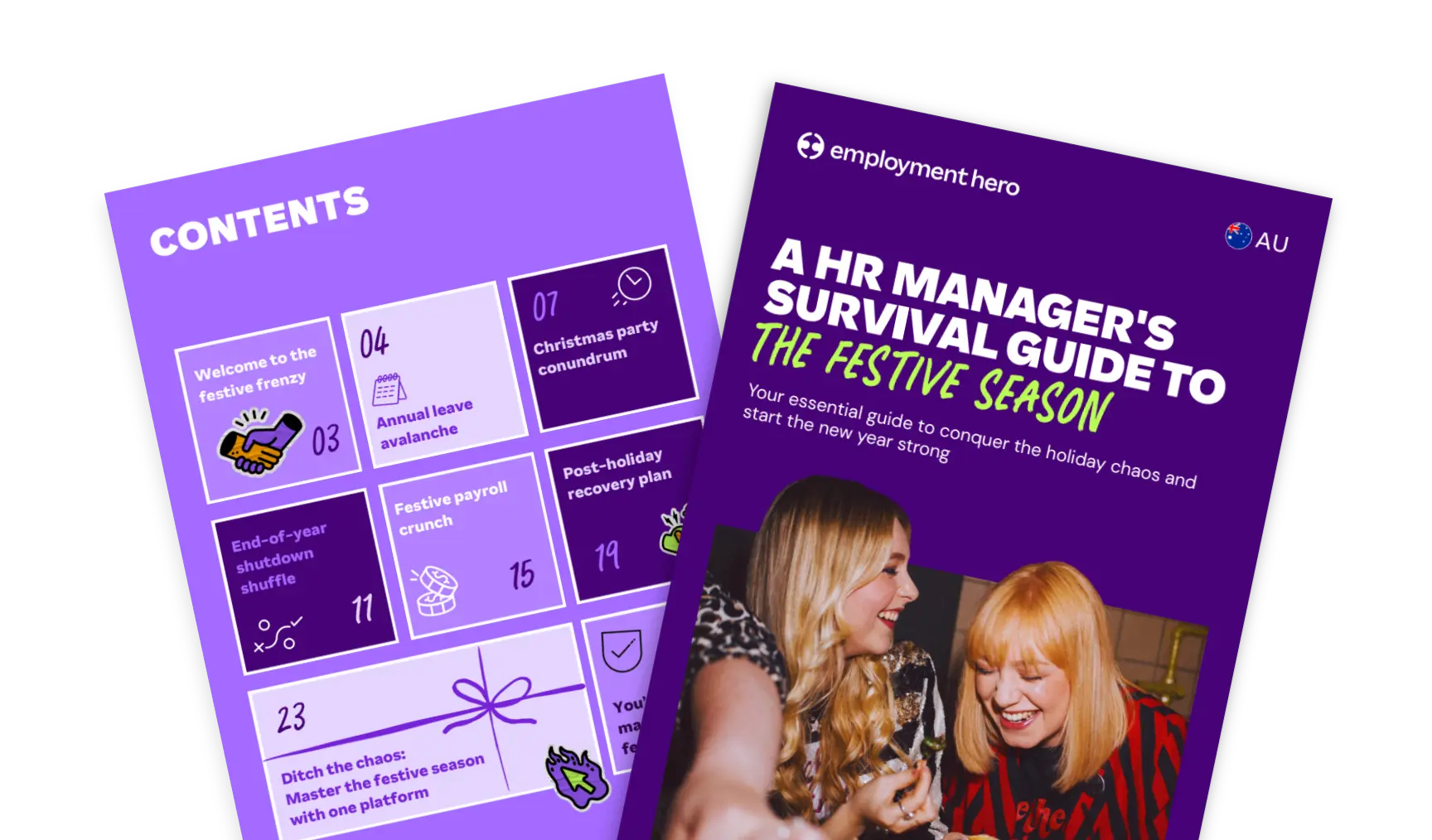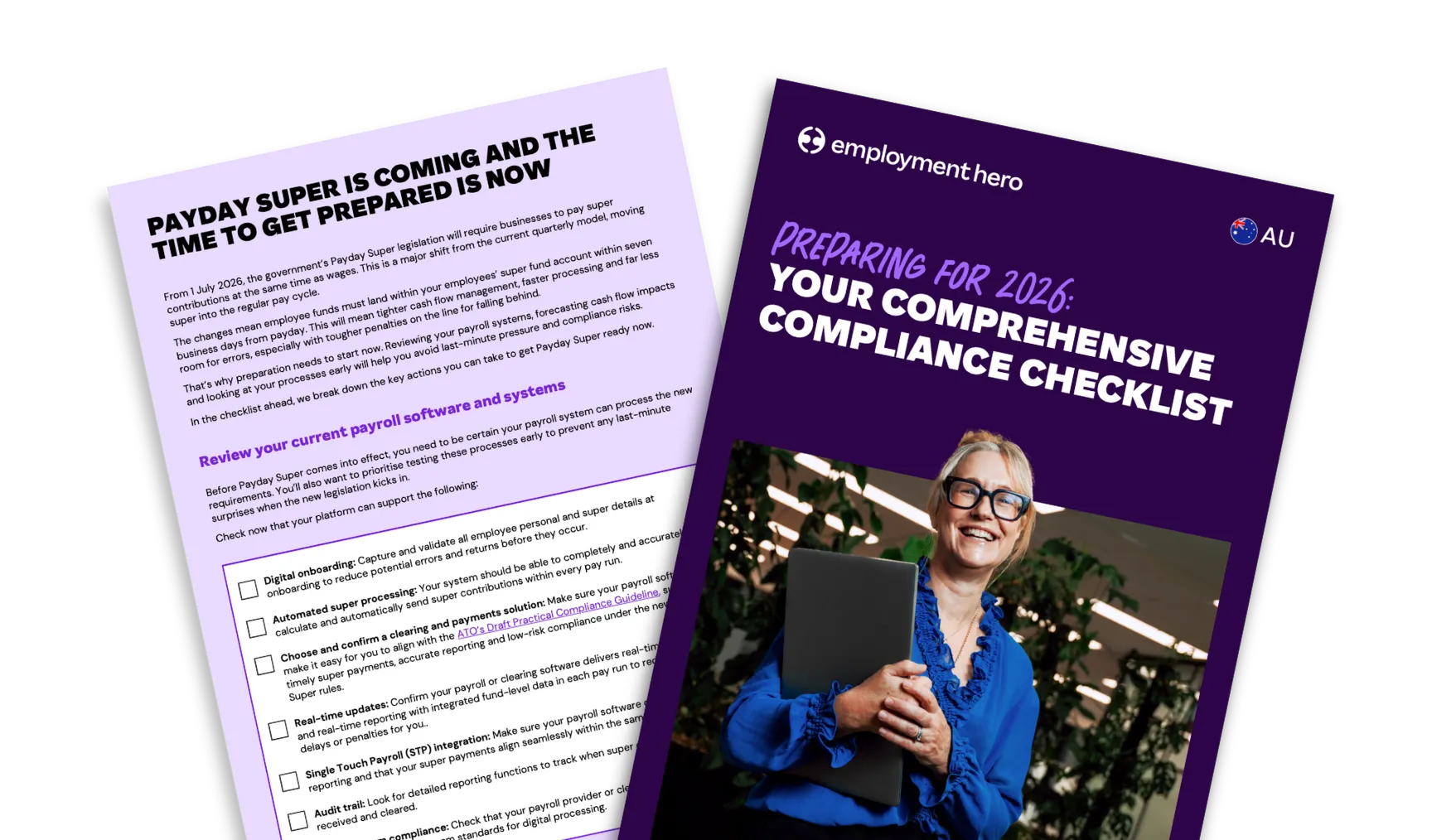The complete guide to HR metrics
Published
The complete guide to HR metrics
Feeling overwhelmed by all that Human Resources (HR) data at your fingertips? You’re not alone. As HR professionals and business leaders, you’re sitting on a goldmine of information that could transform your organisation, but many teams find it challenging to turn those numbers into meaningful insights.
Let’s change that together and discover how to measure what truly matters for your people and your business.
What’s included in this guide?
In this comprehensive guide, we’ve created a clear roadmap to help you navigate the world of HR analytics with confidence. No matter if you’re just getting started or looking to level up your data game, we’ve got your back with simple strategies to tell powerful stories with your numbers.
Here’s what we’ll cover in this guide:
- Understanding HR metrics: The basics of key HR metrics and why they actually matter to your daily work. Plus, how your HR data is the secret sauce for smarter decisions, and making those numbers tell a story that leadership will listen to.
- Measuring people & performance: Simple ways to check how happy your employees really are, practical approaches to boost and track employee engagement, and getting to the bottom of why people leave and how to keep your best talent.
- Strengthening HR impact: Assessing which of your HR initiatives are working (and which aren’t), giving your HR teams the confidence to use data in conversations, and streamlining those time-consuming HR processes everyone complains about.
- Practical implementation: Turning your human resources function into a strategic powerhouse, and finding the right tools to support your team.
Why are HR metrics important?
Ever walked into a meeting with senior leadership and felt that sinking feeling when asked, “What’s the actual impact of that wellbeing program we invested in?” Without solid HR data to back you up, you’re left with vague anecdotes and gut feelings.
Or perhaps you’ve watched helplessly as a department loses top talent, with no clear signals to explain why your number of employees keeps dropping.
It’s well known that when decisions are made on hunches rather than hard facts, your HR initiatives risk missing the mark completely. On the flip side, the most important HR metrics can fundamentally transform how your HR functions deliver value, elevating your entire team from administrative record-keepers to strategic drivers of business success.
Let’s explore exactly how these metrics create this transformation.
Understanding employee satisfaction
How many times have you implemented a new employee workplace policy or benefit, only to wonder if it’s actually making anyone happier?
When you regularly track how content your people are, you gain early warning signals about workplace issues before they escalate into resignation letters.
The right satisfaction metrics help you identify exactly which departments need attention, which managers might need additional support, and which benefits actually move the needle versus those that look good on paper, but deliver little value.
Understanding employee engagement
There’s a world of difference between employees who show up and those who show up and give their all. Engagement metrics reveal who’s merely present and who’s genuinely invested in your company’s success.
Without measuring engagement, you might mistake silence for contentment when it’s actually quiet disengagement brewing. Imagine rolling out a major company initiative only to face a wall of passive resistance because you missed the early signs of disconnection.
Using the right HR software, with proper HR analytics around engagement, lets you spot departments that are buzzing with energy, versus those where innovation and enthusiasm have flatlined, allowing you to intervene before productivity and morale take a nosedive.
Reducing turnover rate
Every time someone valuable walks out the door, they take institutional knowledge, client relationships, and a chunk of team morale with them, not to mention the eye-watering costs of replacement.
With the right turnover metrics, you can identify patterns. Perhaps it’s certain managers who can’t retain staff, specific roles with unrealistic expectations, or compensation packages that aren’t competitive.
Without these insights, you’re constantly in reactive mode, scrambling to fill vacancies rather than addressing root causes. Strong turnover analytics transform your approach from desperate backfilling to strategic retention.
Improving recruitment efficiency
How many hours have your HR teams spent on hiring processes that drag on for months, only to end with mediocre candidates or, worse, new hires who leave within weeks?
When you measure recruitment metrics properly, you discover which channels bring your best performers, how long your ideal hiring timeline should be, and where qualified candidates are dropping out of your process.
Without this data, you’re essentially throwing money at recruitment like it’s a lottery ticket, hoping something eventually works. Smart recruitment metrics mean every dollar spent on hiring delivers maximum return through better quality candidates and shorter time-to-productivity.
Aligning HR with business outcomes
Without connecting your human resources initiatives to concrete business results, you’re constantly fighting for budget and recognition.
When you establish clear links between HR data and business performance, everything changes. Suddenly, your wellness programme isn’t just a nice-to-have, it’s directly tied to reduced absenteeism and increased productivity.
What are key HR metrics?
There are dozens of HR metrics you could track, but organisations that excel don’t drown themselves in vanity metrics. They focus on meaningful measurements that directly connect to business goals and employee experience.
While your competitors might be showcasing flashy engagement scores in quarterly presentations, truly strategic HR teams are tracking HR KPIs that drive actual decisions and meaningful change.
Employee net promoter score (eNPS)
This measures how likely your employees are to recommend your organisation as a place to work. It’s a powerful indicator of overall satisfaction and cultural health, giving you a single number that can be tracked over time to gauge the impact of your HR initiatives on employee sentiment.
Voluntary turnover rate
This tracks the percentage of employees who choose to leave your organisation. By segmenting this metric by department, tenure, performance level, and demographics, you can identify exactly where retention issues exist and target your interventions precisely where they’ll have the most impact.
Time to fill
This measures how long it takes to fill an open position from the moment it’s approved. A lengthy time to fill doesn’t just leave teams short-staffed, it signals potential issues in your recruitment process, compensation structure, or employer brand that need addressing.
Average salary benchmark
This measures how your compensation aligns with market rates across different roles and levels. Tracking average salary data helps ensure your pay remains competitive, supports fair compensation practices, and provides critical information for managing your total rewards strategy effectively.
Cost per hire
This calculates the total expense of bringing a new employee on board, including advertising, recruiter costs, onboarding resources, and productivity loss. Understanding this figure helps you allocate recruitment budgets effectively and evaluate the ROI of different hiring channels.
Training effectiveness
This gauges how well your learning and development programmes actually improve performance and capabilities. Rather than just tracking hours spent in training, this metric connects learning activities to measurable skill improvements and business outcomes.
Revenue per employee
This shows how much revenue your organisation generates divided by your number of employees. It’s a fundamental productivity metric that demonstrates HR’s contribution to overall business performance and helps justify investments in people development.
Diversity metrics
These track the representation and advancement of different demographic groups throughout your organisation. Beyond mere compliance, these metrics reveal whether your talent acquisition and development strategies are truly creating an inclusive environment where diverse talent can thrive.
How frequently should important HR metrics be measured?
Different organisations need different rhythms for their essential HR metrics. Here’s how to find that sweet spot that gives you actionable insights without drowning your team in constant number-crunching:
For smaller companies (under 50 employees)
In small organisations where everyone knows each other by name, subtle shifts in team dynamics can have outsized impacts. A nimble approach works best:
- Monthly: Track your core metrics, like voluntary turnover rate and employee satisfaction, through quick pulse surveys. With fewer employees, each departure or disengagement has a proportionally larger effect on your operations.
- Quarterly: Conduct more comprehensive reviews of recruitment effectiveness and training impact. This gives you enough data points to spot meaningful patterns without overwhelming your likely small HR team.
- Annually: Complete a thorough analysis of compensation benchmarking and total rewards effectiveness. This timing aligns well with typical budget planning cycles in smaller organisations.
For mid-size companies (50-500 employees)
At this size, you’re navigating the complex middle ground. You’re big enough to need systematic approaches but perhaps without the robust HR analytics resources of larger corporations:
- Bi-weekly: Monitor basic workforce metrics like headcount changes, current vacancies, and time-to-fill for critical roles. This frequency helps you stay responsive during growth phases.
- Monthly: Review department-level engagement indicators, absence patterns, and new hire performance. This cadence helps identify departmental issues before they spread.
- Quarterly: Conduct deeper dives into turnover reasons, recruitment channel effectiveness, and learning programme impact. This timing gives you enough data to make meaningful interventions.
- Semi-annually: Analyse compensation competitiveness, internal mobility patterns, and diversity metrics. This schedule allows for mid-year corrections if needed.
For large corporations (500+ employees)
With substantial employee populations and dedicated HR analytics teams, larger organisations can implement more sophisticated measurement approaches:
- Weekly: Track real-time dashboards of critical metrics like open positions, offer acceptance rates, and turnover in high-priority roles or departments.
- Monthly: Review comprehensive HR scorecards with departmental breakdowns of all key metrics, allowing for rapid identification of outliers and hot spots.
- Quarterly: Conduct statistical analysis of correlations between HR metrics and business outcomes, helping demonstrate the concrete impact of human resources initiatives.
- Annually: Perform predictive analytics on workforce trends, succession planning effectiveness, and long-term talent pipeline health.
Whatever schedule you choose, consistency is crucial. Erratic measurement leads to missed trends and missed opportunities. When you measure your HR KPIs consistently, you’ll spot seasonal patterns correctly, your leaders will actually use your insights, and you’ll build efficient processes that connect HR wins directly to business results, all without drowning your team in never-ending data collection.
Using HR data to drive stronger HR functions
So you’ve gathered all this brilliant HR data, now what? Here’s how to turn your metrics into meaningful action that elevates your entire HR function:
Connect metrics to specific HR initiatives
Notice your employee engagement scores dropping in the marketing department? Don’t just present the numbers and hope someone else figures out what to do. Use your data to design targeted interventions. Maybe it’s time for that flexible working pilot program you’ve been considering. Once implemented, track the before-and-after impact regularly.
Make insights accessible to managers
Create simple, visual dashboards that help team leaders understand their people metrics without needing a statistics degree. When managers can easily spot flight risks or skills gaps, they become partners in implementing solutions.
Use predictive rather than reactive analytics
Stop using your HR data just to explain what went wrong last quarter. Run “what-if” scenarios to forecast potential issues before they materialise. When you present proactive solutions to problems that haven’t yet happened, leadership starts seeing HR as genuinely strategic.
Create a feedback loop for HR processes
Use your metrics to continuously improve your own HR functions. If your time-to-hire remains stubbornly high despite multiple interventions, it might be time to completely reimagine your recruitment process rather than make incremental tweaks.
Translate HR metrics into business language
Don’t just report that training hours have increased, show how that additional learning has improved productivity and costly errors have reduced. When HR metrics are framed in terms of revenue impact, cost savings, or risk reduction, you dramatically increase leadership buy-in.
Which tools can help leverage and track HR metrics?
The right HR tools can transform mountains of people data into actionable insights without the headaches. While spreadsheets might feel comfortable and familiar, they’re actually holding your HR function back, often requiring constant maintenance, creating version control nightmares, and offering limited analysis capabilities.
Purpose-built employment technology unlocks entirely new possibilities for understanding and optimising your workforce..
An organisation’s HR toolkit typically consists of several specialised systems:
- Human Resource Information System (HRIS) centralises employee data and establishes a single source of truth for core employee information.
- Applicant Tracking Systems (ATS) streamline recruitment while generating metrics on source effectiveness and hiring efficiency.
- Performance Management Systems track ongoing feedback and development, connecting individual contributions to broader goals.
- Employee Engagement Platforms gather and analyse feedback to provide real-time insights into workforce morale and satisfaction.
- HR audit checklists provide structured frameworks to systematically review your people processes and metrics. Regular audits using these checklists help identify gaps in your HR data collection, ensure compliance, and prioritise areas for improvement.
- Learning Management Systems (LMS) track training completion and skills development to identify gaps and measure learning effectiveness.
- Workforce analytics tools offer advanced analysis and visualisation capabilities that reveal patterns invisible in basic reporting.
For most organisations, however, an all-in-one Employment Operating System like Employment Hero makes the most sense.
Our comprehensive platform combines all these functionalities into a single cohesive system, eliminating data silos and providing seamless visibility across the employee lifecycle. With everything in one place, you gain unparalleled access to integrated data that connects recruitment metrics to performance outcomes, links learning investments to productivity improvements, and correlates engagement scores with retention patterns.
Plus for companies looking for an extra helping hand, our HR advisory services can provide expert employment advice, unique to your business.
Before you download the guide, we just need some details:
Related Resources
-
 Read more: HR Managers: Don’t just survive the festive season, master it
Read more: HR Managers: Don’t just survive the festive season, master itHR Managers: Don’t just survive the festive season, master it
Make year-end easier: manage leave, payroll, parties and shutdowns with confidence. Get practical tips for Australian SMEs. Download the free…
-
 Read more: Preparing for 2026: Your Compliance Checklist
Read more: Preparing for 2026: Your Compliance ChecklistPreparing for 2026: Your Compliance Checklist
Get your business ready for the 1 July 2026 changes. See practical steps for Payday Super, cash flow planning and…
-
 Read more: Monthly business budget template for employers
Read more: Monthly business budget template for employersMonthly business budget template for employers
Plan your monthly income and expenses with our free monthly business budget template. Download today to track cash flow and…























